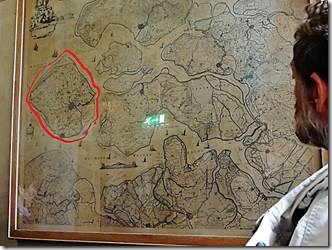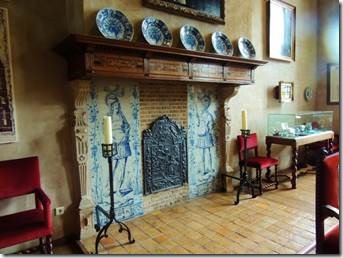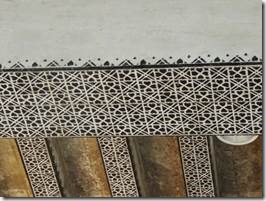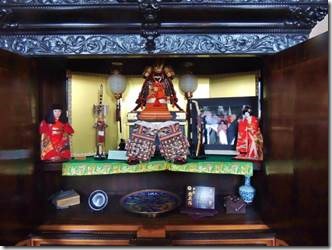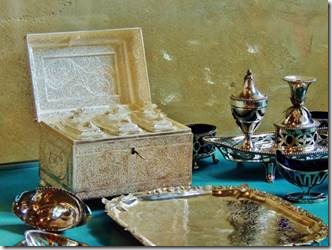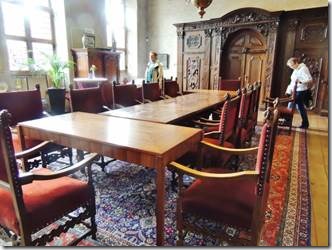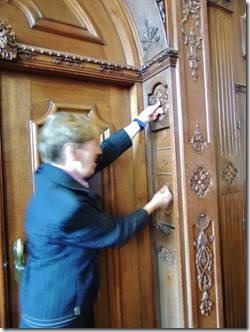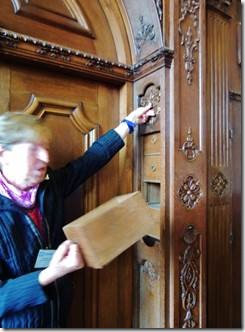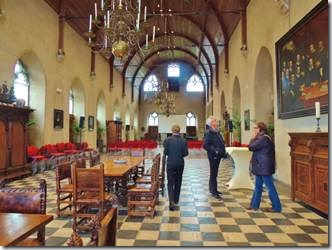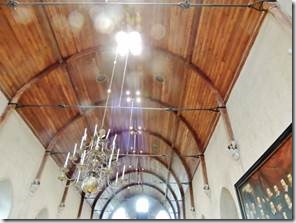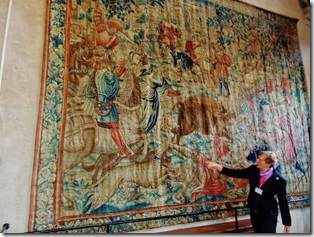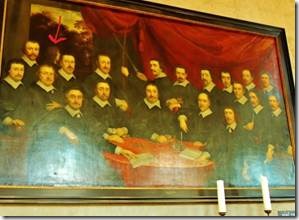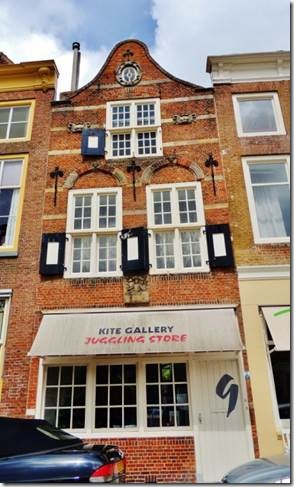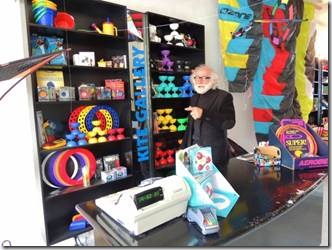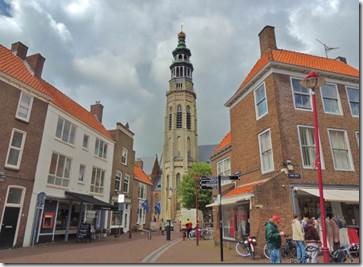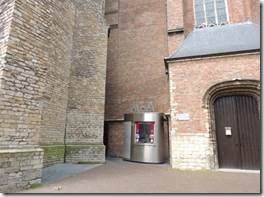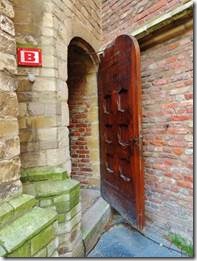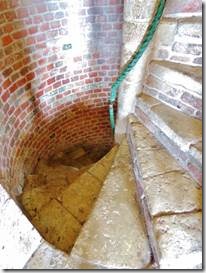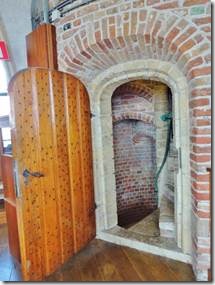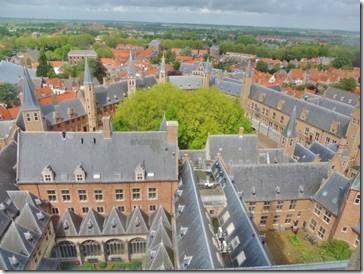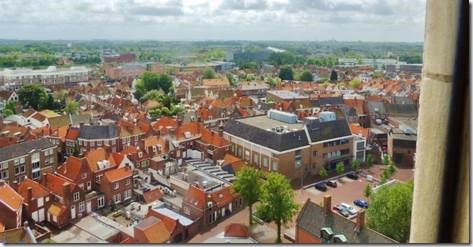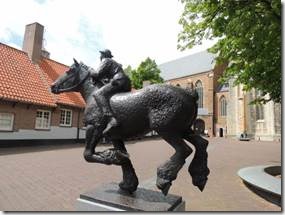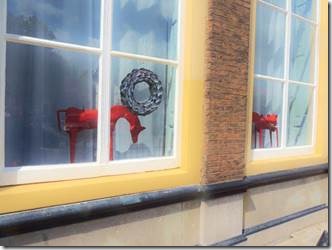Goedenavond,
It has been a lovely long day. Randal and Rick went off to Rotterdam on boat chore errands and Mary and I went across the river to visit Dordrecht. Lots and lots to see! Someday I’ll catch up with where we are when I’m actually writing an email. Tomorrow we leave about 9 am continuing on our journey to Germany and the Rhine.
Ru
Middelburg part 2
|
The circled part on the map includes both Middelburg and Vlissingen in what was Zeeland when the area that is now The Netherlands was at a point in history when they were separate islands and provinces. |
|
Delft tiles around the fireplace and ceiling decoration is painted concrete made to look like early Dutch tiles around the old wood pieces of the renovated ceiling. There wasn’t’ enough wood to do the entire ceiling so this ingenious cement-work was used also. |
|
Gifts from Nagasaki; the sister city of Middelburg |
|
A beautiful locked teabox. Only the mistress of the home had the key as tea was an expensive luxury at one time. |
|
The former town hall meeting room is just through those heavy wood doors. We can’t remember what this room was specifically used for but we all remember those carved doors. They were once bed-cabinet doors. People slept in giant closets to keep the warmth in. These doors from the sleeping cabinet were those of a very wealthy man. Our guide showed us the secret money drawers on either side so the sleeper would awaken if anyone was trying to steal his money. You would lift up the sliding decorative covering and then pull out the drawers. |
|
Town Hall Interior : The former Cloth Hall The interior of the Town Hall is open to the public. Above the old Meat Hall (now occupied by an exhibition of modern art) is the imposing Burgerzaal (Burghers’ Hall), originally the town’s first Cloth Hall, which is now used for civic receptions and other great occasions and as a concert hall. Items of particular interest include pictures, Bruges tapestries on mythological themes and a bronze model of Admiral de Ruyter’s flagship. http://www.planetware.com/tourist-attractions-/middelburg-nl-zld-mid.htm The barrel ceiling, which is called that because it looks like a half barrel, was once over an attic space where hams were hung. The Cloth Hall was below that and then the Meat Hall below. The City Fathers liked having both the meat and cloth halls nearby so they could judge the amount of taxes that should be paid from both of those markets. |
|
The Bruges Tapestry and a group portrait with one cheapskate who wouldn’t pay the fee for a face portrait so he was painted from the back. See the red arrow. This was a shooting club where everyone was sort of related to everyone so they all sort of look alike. Our guide explained the discoloring of the Bruges tapestry: the yellow color faded from the green threads leaving blue color where you would expect green. And she showed us the brown which was the newly discovered madder color gotten from plant roots. “Materials “Wool is the most widely used material for making the warp, or the parallel series of threads that run length-wise in the fabric of the tapestry. The width-running weft, or filling threads, are also most commonly made of wool. The advantages of wool are wide-ranging. It is more available, more workable and more durable than other materials, and in addition can be easily dyed. Wool has often been used in combination with linen, silk or cotton threads for the weft. This mixture of material is ideal for detail weaving and for the creation of delicate effects. Light coloured silks were often employed to create pictorial effects of tonal gradation and spacial recession. The glow of silk thread was often useful for highlights or to create a luminous effect when contrasted to the duller woollen threads. Silk was increasingly used during the 18th century, especially at the Beavais factory in France, in order to achieve subtle tonal effects. The majority of Chinese and Japanese tapestries have both warp and weft threads of silk. Pure silk tapestries were also made during medieval times at Byzantium (Constantinople) and in parts of the Middle East. Pure linen tapestries were woven in ancient Egypt, while Egyptian Christians and Medieval Europeans sometimes used linen for the warp. Both cotton and wool were used in Pre-Columbian art to make Peruvian tapestries as well as some Islamic tapestries during the Middle Ages. Since the 14th century, along with wool and silk, European weavers have also used gold and silver weft threads to produce a sumptuous effect. Tapestry Dyes Dyes commonly used in Europe included: (1) Woad, a plant similar to indigo, which yields a good range of blues. (2) Madder, a root from which reds, oranges and pinks could be obtained. (3) Weld, an English plant whose leaves produce yellow. (4) A mixture of weld (yellow) and indigo (blue) was used to concoct green. “ |
|
My friend Sharon’s son Warren is a professional juggler/street performer. So I had to visit this Juggling Store and have a chat with the owner who is more a kite man himself. I would have loved to explore the building from the 1660s which might have been possible as the door was open and no one was in the ground floor shop. I called and waited and called and waited and finally the owner came from either up or down. Many buildings that look old were rebuilt after the war, but some with the dates of the 16 and 17 hundreds I’m assuming are original. http://www.njf2014.nl/en/index.html is the site of the 2014 Netherlands Juggling Convention |
|
Seems I can’t resist a good climb so we went off the climb the tower of Lange Jan “The octagonal tower – a rare feature in the Netherlands – popularly known as Lange Jan, originally dating from the 14th century but several times burned down (most recently in 1940), is the great landmark and emblem of Middelburg. A staircase of 207 steps leads up to the top (91m/299ft), which carries a large imperial crown in honor of Count (King) William II. From the top of the tower there are extensive views over the whole of Walcheren and much of the Deltawerken. “ |
|
The Abbey Complex Nieuwe Kerk “In Middelburg, the two-aisled Nieuwe Kerk (16th C.), the parish church, and the aisleless Koorkerk (early 14th C.), the abbey church (beautiful reticulated vaulting), were originally joined. Since the parish church had no choir of its own, the west end of the monks’ church, known as the middle choir, was used as the choir for the lay congregation. Over this is the tower known as Lange Jan ("Long John"). In this church are the double tomb of the brothers Jan and Cornelis Evertsen, two admirals killed in the English war of 1666, and memorial tablets for Count William of Holland (d. 1256), king of Germany, and his brother Floris (d. 1258). The magnificent marble tomb was the last great work of Rombout Verhulst (1680-82). After their restoration both churches were provided with organs by the Rijksmuseum in Amsterdam. The organ in the Koorkerk (built in 1481) came from St Nicolaaskerk in Utrecht, that in the Nieuwe Kerk (1892) from a Protestant church in Amsterdam.” |
|
Middelburg |
|
Horse statues of all sizes “The Ring Rider.” Hooves pound the sand and nostrils flare as the horses run full speed toward the ring – an oh-so-small ring. This is the age old sport of the equestrian ring rider. A traditional sport from long ago still played out today in Middelburg, Zeeland, a province in Holland. A true test of horsemanship, the rider must be bareback – without the aid of a saddle- and the horse must be colorfully decorated. The ring rider is also dressed in an official costume of white with an orange sash, symbolizing the connection to the royal house. A centuries old horseback riding activity dominated by male equestrians, today, women are allowed to join in the festivities on horseback or with carriages where the man directs the coach and the woman stabs the rings that are hung in various places along the course. |

